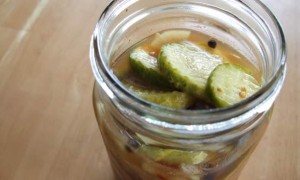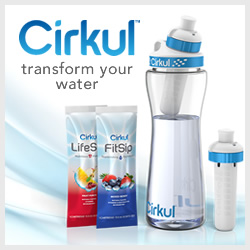 These pickles are slightly sweet with just a hint of spicy-ness. They taste similar to a bread and butter style pickle, but with the added benefits of lacto-fermentation. The bad thing about these tasty pickles are that they never seem to last in my house… they get eaten up so quickly. I just may have to lock the kids out of the refrigerator so that I get to eat more than just a few slices of these 🙂 If you look at the photo, you’ll see that they had already gotten to them before I go to take a picture… the jar was full. (Well, at least I know these pickles are so good for them… so really it’s a good thing that they enjoy them so much.)
These pickles are slightly sweet with just a hint of spicy-ness. They taste similar to a bread and butter style pickle, but with the added benefits of lacto-fermentation. The bad thing about these tasty pickles are that they never seem to last in my house… they get eaten up so quickly. I just may have to lock the kids out of the refrigerator so that I get to eat more than just a few slices of these 🙂 If you look at the photo, you’ll see that they had already gotten to them before I go to take a picture… the jar was full. (Well, at least I know these pickles are so good for them… so really it’s a good thing that they enjoy them so much.)
- 1 pound pickling cucumbers
- 1/2 cup mild onion, thinly sliced
- 2/3 cup maple syrup (honey is anti-bacterial in nature, so will not make a good substitute)
- 2 teaspoons ground cinnamon, or use a small piece of cinnamon stick crumbled
- 1/2 teaspoon whole all-spice berries
- 5 whole cloves
- pinch (1/16 tsp.) ground ginger
- pinch (1/16 tsp.) dill seed
- 1 teaspoon mustard seed
- 1/4 teaspoon celery seed
- 1/8 teaspoon red pepper flakes
- 2 teaspoons unrefined sea salt
- 2 Tablespoons fresh lemon juice
- 4 Tablespoons whey (see how to obtain whey)
- 1 small bay leaf, organic is preferred
- filtered water, if needed
Other Items you will Need:
1-quart sized wide-mouth jar (preferably with air-lock lid)
If cucumbers are not freshly picked, soak in very icy water for a couple of hours. Keep in ice water until ready to slice/put into jars.
Bring maple syrup and all of the spices (including salt, but not bay leaf) to a boil over medium heat. Immediately remove from heat and let spices steep until liquid has cooled to room temperature.
Cut cucumbers into 1/4-inch slices. I used my mandolin with the blade that has ridges, but you can also just cut by hand with a knife. Carefully arrange and alternate pickle slices with onion slices inside a 1-quart sized wide-mouth jar (preferably with air-lock lid), laying them as flat as possible. Place the bay leaf some where in the middle of the jar, between the slices.
When maple syrup-spice mixture is cooled, stir in the lemon juice and whey. Pour this mixture over the cucumber slices in the jar, add additional filtered water to cover pickles as needed. Be sure to leave 1-inch of space from the top of the jar to allow for expansion.
Screw storage (solid) lid on-top of jar tightly. Give the jar a very gentle shake, from side-to-side, to mix any water you added with the syrup and spices. Open jar back up, push any cucumber slices back down into the brine if needed.
Place lid (preferably air-lock lid) on the jar tightly. If using air-lock fill with water according to instructions. Allow to ferment, at room temperature, for 2 days.
Remove air-lock lid, if using, and replace with storage lid — transfer to cold storage. (These pickles also get better after several days in the fridge….but it’s hard to make them last that long.)
Makes 1-quart


Can I use stevia instead of maple syrup? I am very sensitive to carbs due to hypoglycemia.
Hi, thanks for this recipe. I’m wanting to start fermenting my own pickles but really can’t stand dill. So happy to find this recipe and can’t wait to try them!
I don’t have a ton of frig space though, so I wondered what temp I need to keep them at, say, in my basement or only slightly heated attic during fall / winter? I have read between 64 degrees F and 58 degrees F for some pickles. I’m wondering anyone’s experience w/ these pickles and if you think that temp range would work?
I’d love to make a yr’s supply, but bottom line, I don’t want my pickles to go to waste!
Thanks
Julie, lacto-fermented vegetables should be kept at a minimum temp of 50 degrees F, preferably closer to or at 40 degrees. If you have a corner of your basement that stays at this temp consistently then you can store them there. Not sure if they would last a year though 🙂 With cucumbers being a “softer” vegetable overall, they do not last as long as other “harder” fermented veggies. So I would say maybe 3 to 6 months on average. After that they are not necessarily “bad”, but will have gotten significantly softer and may not be as palatable to eat.
This is the first time I made them and I followed the recipe using the air lock. Problem is that I forgot about them two days later and left them at room temperature about 18 hours longer. They smell fine but there’s a little white film on top. I’m scared to try them. Do you think I ruined them? Maybe the white was just the whey?
I made the dill pickles and they tasted fine at first but then had a bitter aftertaste. I was thinking it was my home-grown cucumbers that get bitter in the heat of summer. I made the saurkraut and that doesn’t taste very good either. I think there’s not enough juice. So I was hoping I didn’t waste another recipe.
If the film is not fuzzy the sweet pickles are probably okay. Try skimming the film off and if needed also throw away the top layer of pickle slices. Then give it a smell and see what you think, if it smells fine then it most-likely is okay.
I’ve had my dill pickles taste bitter as well, but not all the time. It really has to do with the cucumber itself. I think your comment about the heat of summer was right on.
The sauerkraut does need to stay moist during the complete fermentation process. So it may not have turned out okay, hard to judge because I am not there to see and smell it. Also be aware that the sauerkraut does not taste “as good” after it is just finished fermenting than it does after several weeks of being in the refrigerator. Aging and maturing in the fridge really enhances the taste of the sauerkraut.
The Film is Kahm yeast, and perfectly harmless.
Some say this is from not enough salt, this yeast is found everywhere, and yes the heat will speed up both the fermentation and the yeast. Its when the film is a different color that you have to worry.
By storing it in a cooler location it slows down the firmentatation process, and usually more complex tastes evolve. Try firmenting garlic, leave at 50-60°F for 4 weeks then move to the root cellar or refridge for another 6 or more months, some swear it needs to be 12(I’ll find out in 6 months), but 6 months its almost like garlic candy.
The yeast film varies from season to season and vegetable to vegetable. Keep in mind these are natural ferments, they can act differently at times.
Any idea if these could be made without whey? I’m assuming I could just up the salt but not sure how they would taste that salty. Maybe using a gingerbug as a starter or water kefir?
Yes these could be made without the whey, but as you stated you would need to up the salt and that cold throw them over the edge of being too salty. So that would not be my first choice.
Instead I would try the water kefir in the recipe in place of the whey. And if you do so please report back here and let us all know how it worked out.
How neccessary is the airlock lid?
These sound amazing – but the maple syrup in this quantity for one quart of pickles – that’s pretty expensive. I might just try some sucanat in place of maple syrup.
Okay – so I made a syrup using 2 cups of evaporated cane sugar and 1 cup of water and used it in this recipe for 2 quarts of sweet pickles. They’re already starting to bubble. I LOVE fermentation – so exciting! Will try to remember to report back.
Thanks again for posting this – it’s so great to see that other folks are getting into Nourishing Traditions (title of Sally Fallon’s book regarding same).
I usually stay away from evaporated cane sugar unless I am make lacto-fermented sodas where the majority of it will be consumed in the fermentation process. Evaporated Cane Sugar is simply white “refined” sugar with a little bit of molasses in it for color. I do not think these pickles will need to be processed long enough to consume the sugar.
I like to use instead sucanat or rapadura as it is not refined, the minerals are left intact.
I am interested though, so please so let us know how they turn out 🙂
The air-lock lid is a very important part of lacto-fermentation. It can be done without it, but I would highly recommend it to keep mold at bay. The air-lock lid is also a plus because it really makes your ferments turn out better and so much tastier than without it. Using the air-lock is also good for safety reasons, no worrying about jars exploding from the build up of pressure and gases because the air-lock naturally lets the gas escape.
You could use sucanat in this recipe, but it may make the pickles have a somewhat stronger molasses-y taste. (The maple syrup just gives these pickles a really nice taste, that’s why I like to use it.)
Made a batch of these the other day and followed the recipe exactly. During the two days on the counter, I did not notice any bubbling or other sign of fermentation. The water level in the airlocks was the same as when they started after two days. Opened them and tried them before transferring to the fridge. Seemed mostly like a marinated cucumber, and not pickled.
Not having tried these I am not sure what the result should have been.
Questions:
Does it sound like they turned out the way they should?
If fermentation did not take place, would you think they are safe to eat?
Guy, it is normal to not “see” the signs of fermentation. Sometimes ferments can be really active and sometimes not so active, it varies for time to time. I’m sure you weren’t standing over the jar watching it every second of the day 🙂 Anyhow, it sounds like they turned out fine. If there was no mold present then they should be safe. And remember these aren’t “pickled” in the sense that you might be used to. Since they are not made with vinegar, like commercial pickles, they will not have that over-powering pure vinegar taste.